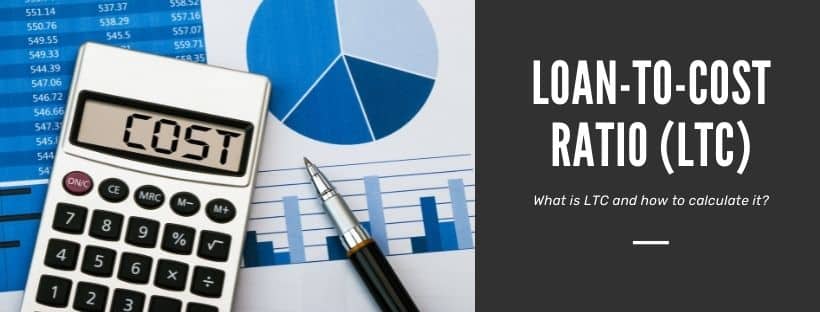Loan To Cost (LTC) Ratio – Understanding LTC vs LTV

Understanding loan to cost meaning is quite important to investors. This ratio is a valuable metric used in commercial real estate construction (and other areas) to determine whether a transaction may be profitable or beneficial to that investor. It compares the cost of financing a project (usually as a loan) to the cost of building the project. By utilizing this metric, lenders can better determine how much risk is present when offering a construction loan for a specific project.
For developers and investors, it also provides insight into the amount of equity retained during the project’s construction.
What Is LTC – How to Calculate Loan to Cost
The loan to cost formula is:
Loan to Cost = Loan Amount / Construction Cost
The loan to cost ratio compares the amount of a commercial real estate project’s financing to the project’s actual cost. The higher the LTC is, the more risk is present for the lenders offering a loan. Often, lenders will not take on very high LTCs, most often capping this at about 80%, though lenders differ on the amount of risk they will consider.
The loan to cost is a representation of the percent of the loan that the lender will provide in financing as compared to the hard cost of building the project. This metric helps an investor in commercial real estate see how much money they need to have on hand to help fund the project. Lenders may only cover 80% of the construction cost, requiring the project owner or investor to seek out other sources for the remaining 20%, for example. Once the construction of the project is complete, the entire project has a new value.
Answer a few questions and get custom mortgage quotes. We'll match you with offers from our network of 650+ lenders.
If the loan to cost ratio is higher, that means the lender is taking on a higher risk transaction. The more the investor puts into the project on their own, the less likely the investor is to walk away from the project, reducing the lender’s risk.
Some lenders allow for a higher loan to cost ratio. This could be 80% or higher. Often, this comes with a higher interest rate on the loan as a type of compensation for the lender. The higher the risk is, the more it costs to borrow funds for the project.
It is important to note that other factors contribute to whether or not a lender will move ahead and offer financing to cover a commercial real estate project like this, but loan to cost is a primary factor.
Other factors may include the location of the project, the value of the property on which the construction will occur, and the borrowers’ credit record. Loan histories are also considered.
Many lenders also look at the investor, builder’s, and project manager’s reputation, credibility, and experience to determine if they should lend to cover the project. The more positive the information available in these areas, the more likely the lender is to move ahead with the loan for the project and to offer a competitive interest rate in doing so.
An Example of How LTC Works
Consider a construction project for a new retail property. The hard construction costs of the property are expected to be $400,000. The investor in the property turns to a lender to secure a loan. The lender is willing to offer up to 80% of the money needed for the project. In this situation, the lender is willing to offer a $320,000 loan to cover the construction costs. That is 80% of the $400,000 project cost. The loan to cost ratio is 80%. The investor must come up with the remaining $80,000 to cover the project before the construction project can get underway.
In doing this, the lender ensures the retail property investor has a stake in the project – $80,000 worth of a stake. As a result, it is less likely for the investor to walk away from the project because they have money in it.
Some lenders require a lower loan to cost ratio. This is a hypothetical example.
Loan to Value Ratio (LTV)
Another important metric when considering commercial real estate construction costs is the loan to value ratio or LTV. The loan to value is a ratio that expresses the percentage of the value of the property that is under the loan.
Lenders use loan to value ratio to determine how much risk is present when taking on the financing. Most lenders require borrowers to contribute to the purchase of the property, such as with a down payment. In commercial real estate, this could be a loan to value ratio that is no more than 80%. That means the loan is worth no more than 80% of the value of the property.
What Is The Difference Between Loan to Cost and Loan to Value?
LTC vs LTV is important to understand.
These two are often confused but need to be fully understood by the investor to ensure they fully recognize the risks of the transaction.
Loan to value is very close to the same as loan to cost. The slight difference is that loan to value takes into account the total loan that is given for the construction project against the value of the project after it is complete. The difference here is that one considers the cost of the construction while the other considers the finished project’s value. The two are often very different.
When using the previous example, the cost of the project is $400,000. That is to build the project. However, upon completion of the retail property, the value of the project may increase substantially. It could be worth $500,000, for example.
In some areas, construction costs are much higher than in others. More so, lenders must take into consideration the risk that the project may not be completed or the end result may prove less beneficial.
How Investors Can Use LTC
Often, LTC is a focus for lenders. Investors and builders of the project recognize that, in order to move the project forward, they need to meet the expected down payment or stake in the project. In the above example, the investor needs to show they have the necessary $80,000 to move the project ahead before the lender offers the $320,000 to equal the combined need of $400,000.
Investors may need to work to build capital reserves to be able to ensure that value is present. They may also have to lower costs on the project if they do not have the necessary capital to put towards the project.
While for many investors, $80,000 may seem smaller, many of today’s largest retail projects are much more significant in value, often in the millions. As a result, those costs add up quickly.
Finding out a Lender’s Requirements
Before investing, commercial real estate investors must spend some time finding a lender that offers an LTC ratio high enough to meet their needs. Most lenders will provide that information upfront prior to application (or investors can ask for it). Keep in mind other factors play a role in lender qualification and approval for a construction loan, well beyond whether or not the project meets LTC requirements.

